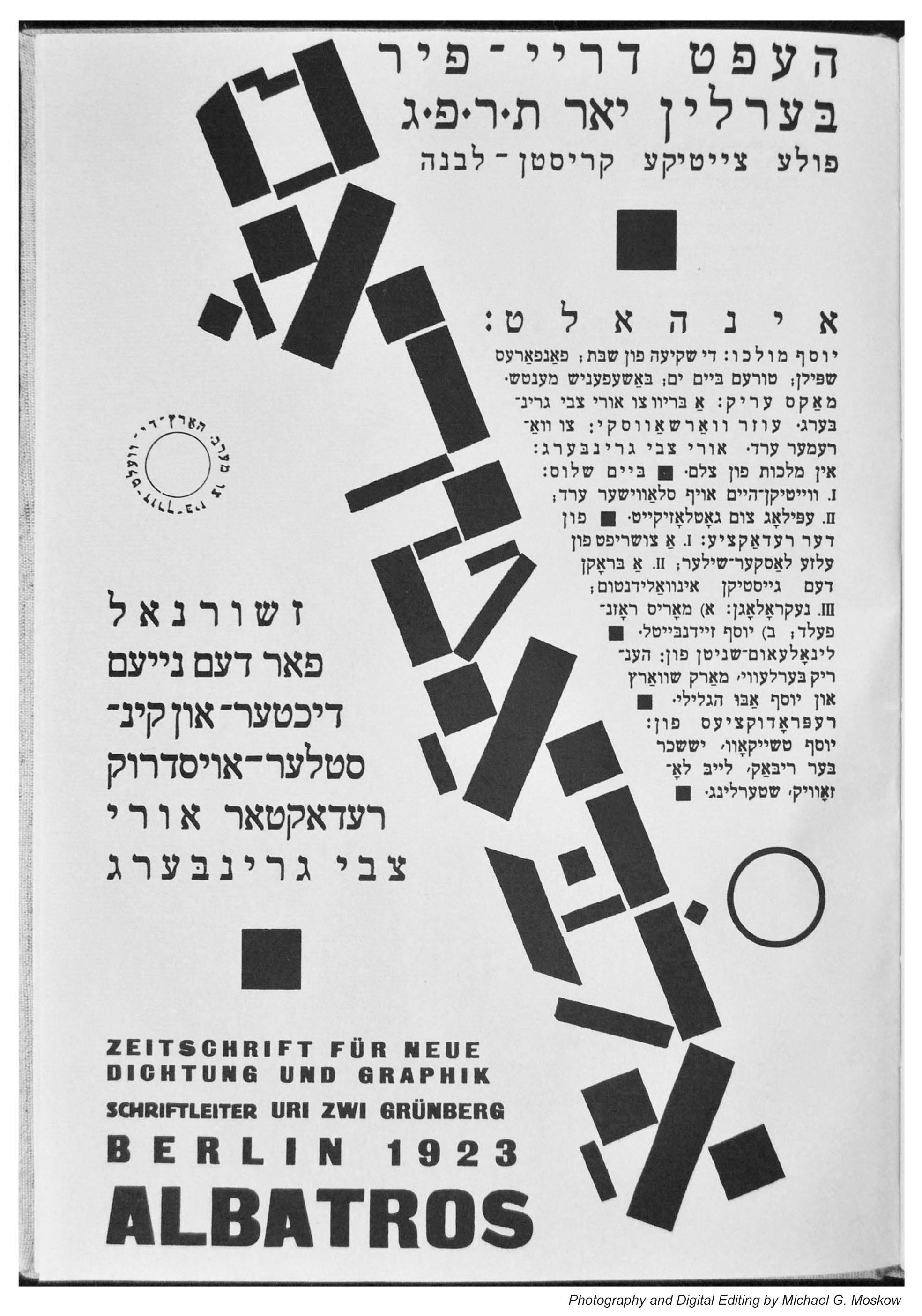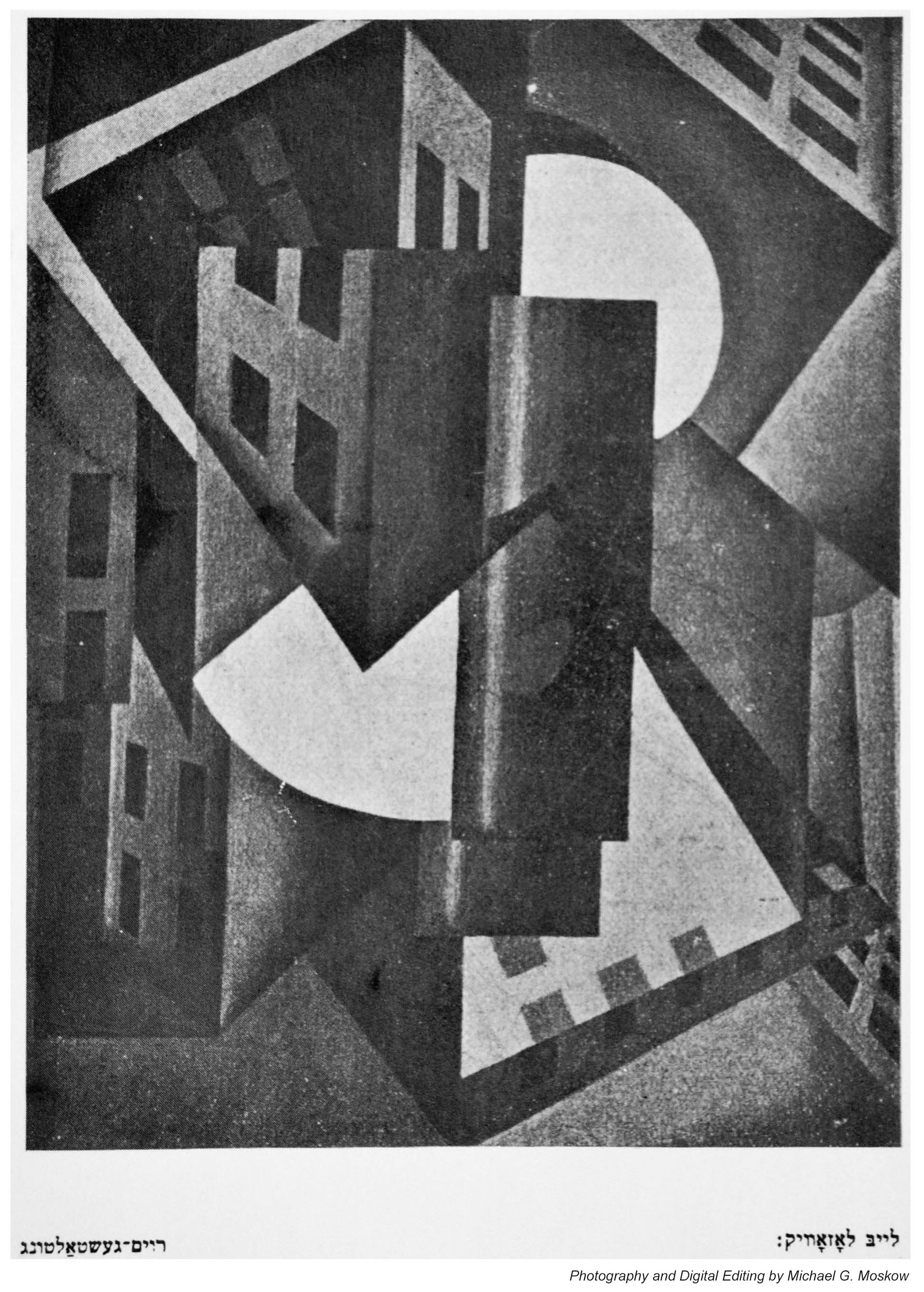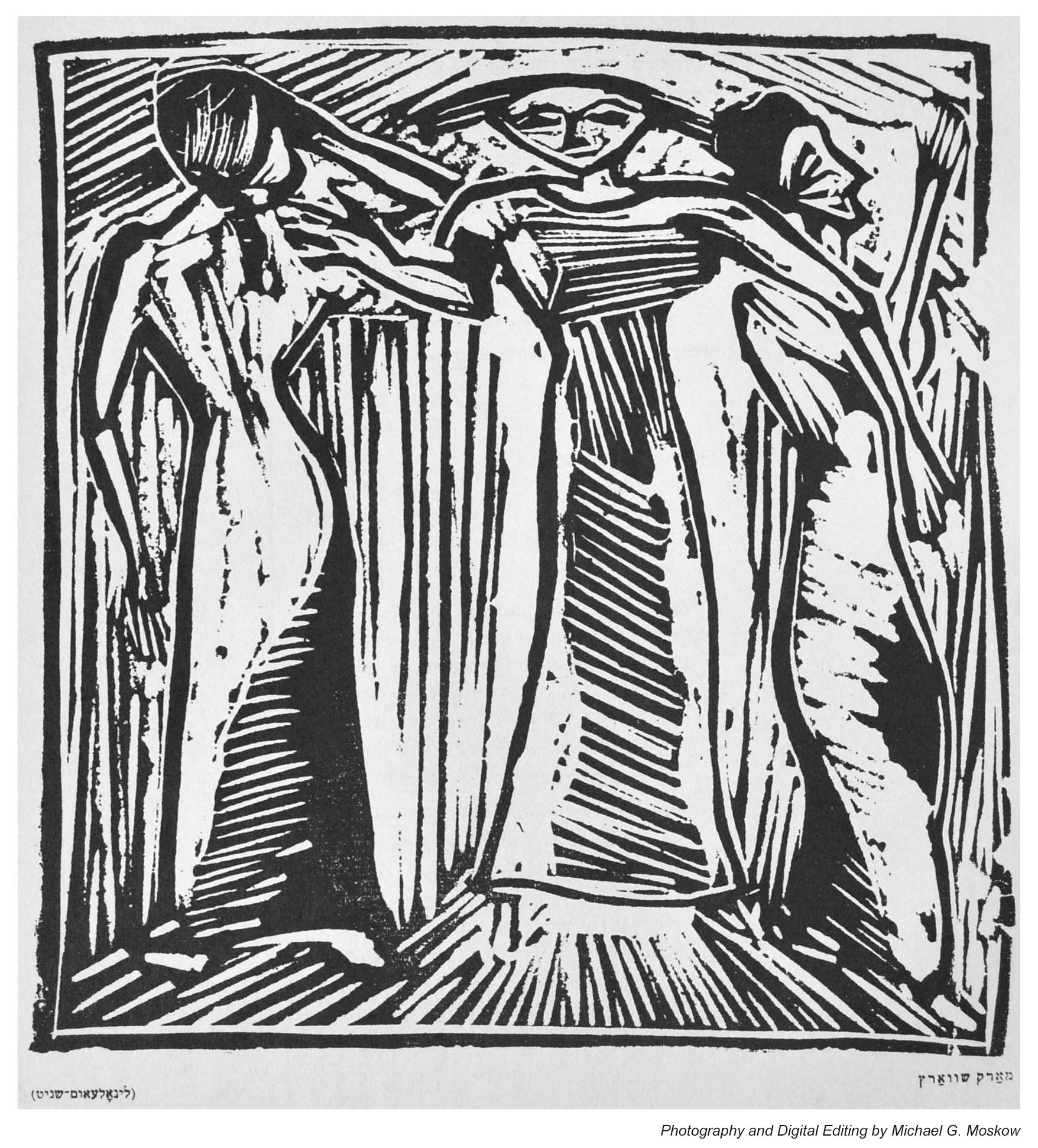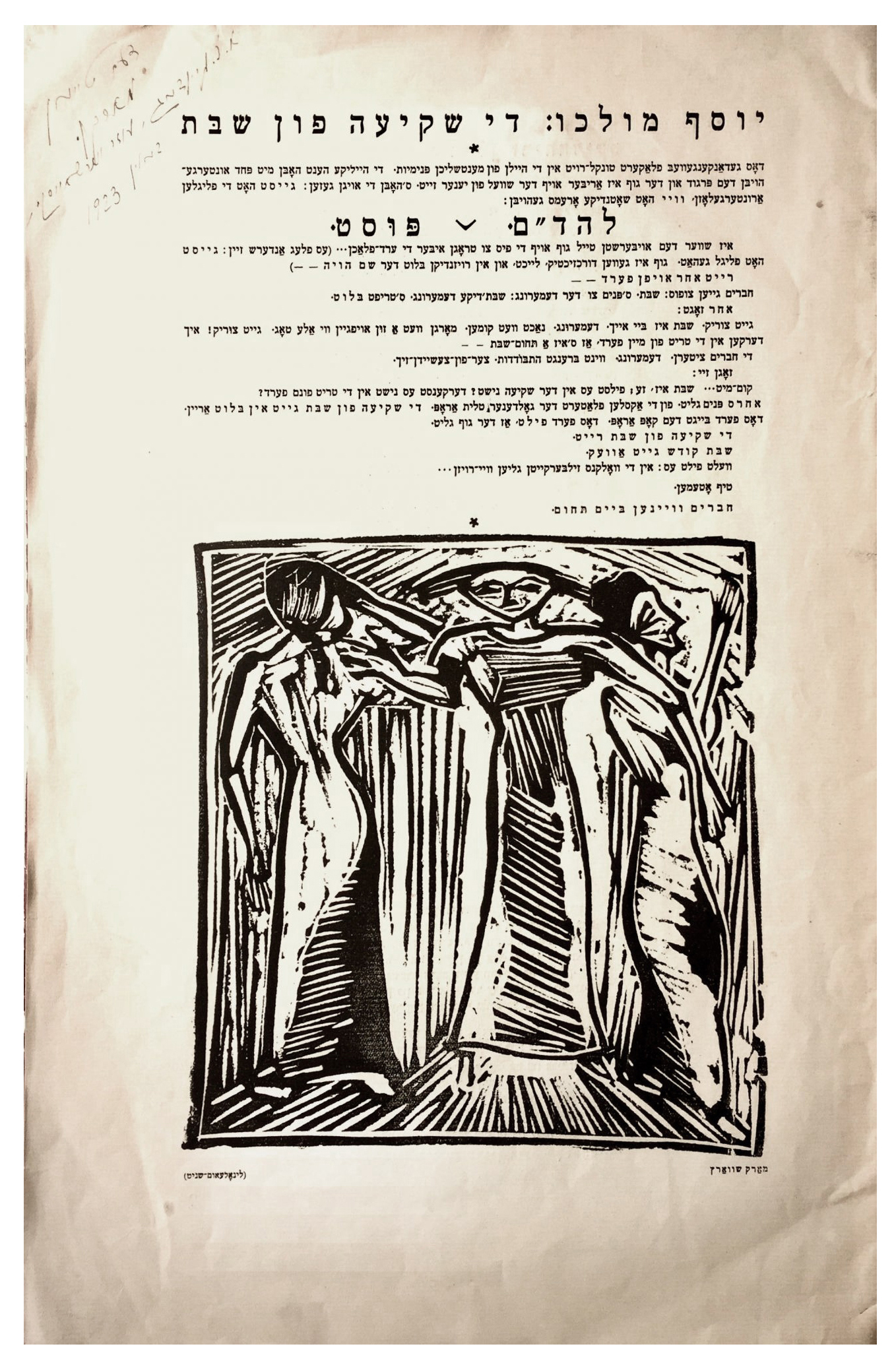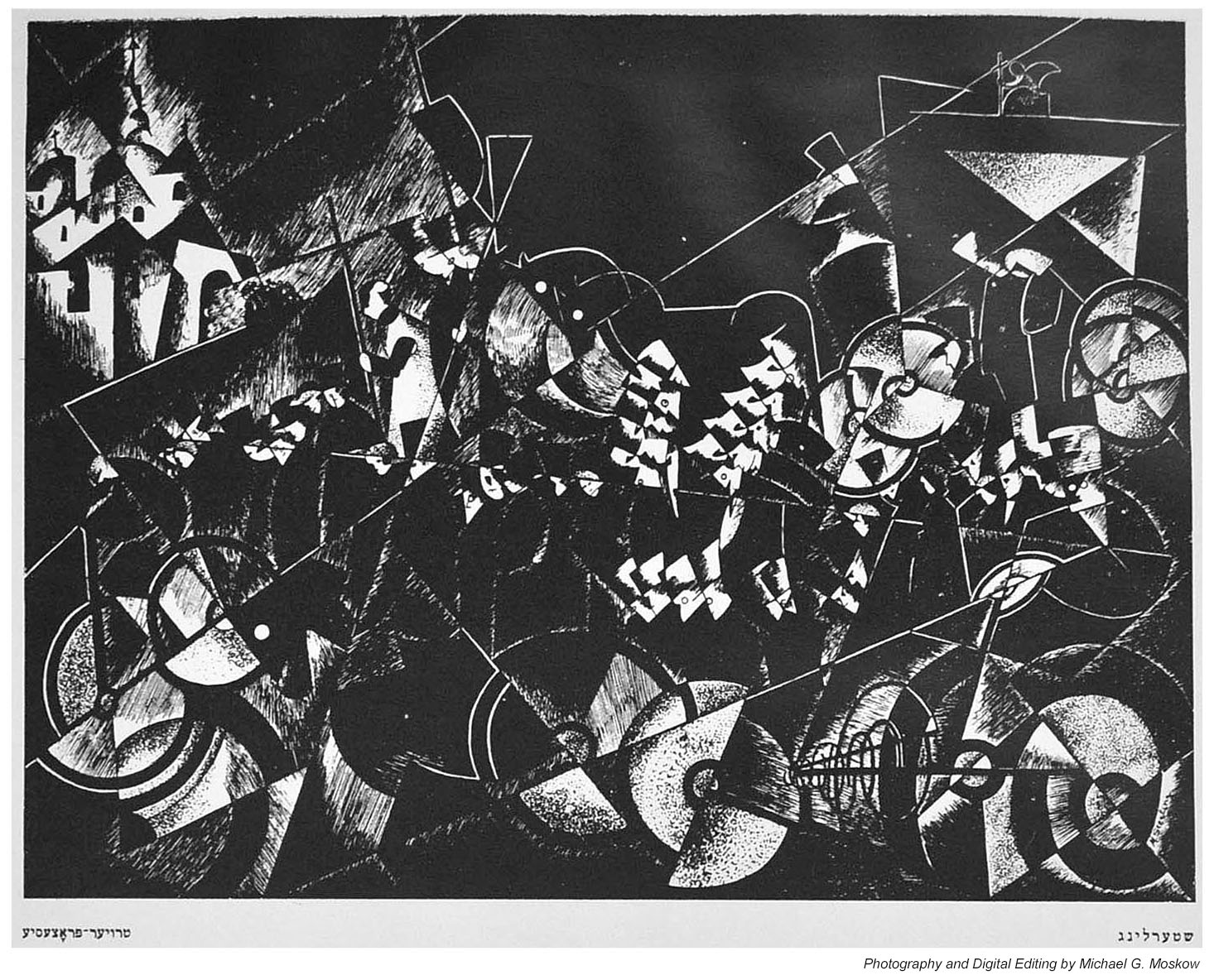Here’s the third of my three posts showing the cover art and interior illustrations of Albatros. This third issue, a double issue comprising numbers 3 and 4, was published in Berlin in 1923.
Here’s Foldari Books’ 2018 catalog description of this combined issue:
“The cover of the last issue (no. 3/4) was created by Henryk Berlewi, the front with a modernist typographic design, the rear with a linocut figure placed in the center. These numbers contain the most illustrations, many were printed on special paper and mounted onto the pages, among them the reproductions of Joseph Chaikov’s sculptures, and Issachar Ber Ryback’s painting. It contains a full page and a smaller sized linocut by Berlewi, and other illustrations by Szwarc, Leib Lozowik (Louis Lozowick), Yossef Abu HaGlili and Sterling (?).”
My photograph of the first page in the 1978 Jerusalem reprint…
…and the issue’s first page, from Foldari. Immediately obvious is the original’s use of red-tinted paper. Not so in the Jerusalem reprint.

Here’s page two of Foldari’s original copy, showing a painting by Leyb Lozovik (Louis Lozowick) entitled “Space” or “Red Circle”, in the form of a photographic print attached to the page.
However, there’s some confusion going on here! In the 1978 reprint, in which – at least, in comparison with the Foldari original above – the photograph (evident by the location of the caption and artist’s signature) has been printed upside down. (Oops.)
You can view an image of the original painting at the Vilcek Foundation, which describes the painting as “oil on canvas board”, of dimensions 18″ x 15″, with an incorrect creation date of 1924. Here’s the painting as it appeared in 2018 at the website of Jonathan Boos. (No longer there in 2024!)
The Roosevelt Island Historical Society provides the following information about Lozovik: “Louis Lozowick was born in 1892 in Ludvinovka, Ukraine, then part of the Russian empire. Lozowick’s interest in art began in 1903 when he enrolled in the Kiev Art School. This early education was a formative experience for Lozowick; he would spend the rest of his career pursuing art studies.
Seeking greater civil and economic liberties, Lozowick followed his brother to New York in 1906. Lozowick arrived at Ellis Island alone, and was stunned by the modern developments of the growing metropolis. New York was unlike anything he had seen during his rural upbringing in Russia, with the vertical architecture and industrialized economy. From 1912 to 1915, Lozowick attended the prestigious National Academy of Design in New York. He studied under Ivan Olinsky, Emil Carlsen, Douglas Volk, George W. Maynard, and Leon Kroll. The curriculum was largely academic in tradition, a style that he felt did not accurately portray the modern city. In 1915, Lozowick began his college studies at Ohio State University, where he graduated in three short years.
He served briefly in the army in 1919 with the U.S. participation in World War I. Immediately after his discharge, Lozowick embarked on a cross-country trip, visiting major industrial cities of the United States. The visual landscape of these cities, filled with smokestacks, factories, skyscrapers, and the expanding network of highways, informed his style in the years to follow.
In 1922, Lozowick traveled to Europe like many like-minded artists seeking avant-garde movements. He first went to Paris, where he studied French at the Sorbonne Institute and surveyed the Cubist masterpieces of Juan Gris and Fernand Léger. He then went to Berlin, a city vibrant with artists and intellectuals. Lozowick was drawn in particular to the Russian Constructivists, who championed the machine aesthetic through abstraction and minimalism. His art career took off in this experimental environment, as he was inspired by the works of El Lissitsky and Kazimir Malevich.
~~~~~~~~~~
Red Circle is a series of overlapping architectural forms and geometric shapes. The repeated window patterns on the starkly linear buildings suggest a landscape of factories; the cylindrical forms at center represent the smoke stacks adjacent to an industrial facility. The grey palette of the composition is further heightened by the dark shadows cast by the buildings from an unidentified light source. Four fractured, red circles overlap with the buildings.”

On page 1 appears a linocut by Marek Szwarc, albeit this work has a title: “Friends Cry at The Border”.
Here’s Foldari’s image of the original. Like other linocuts in Albatros, this piece, too, occupies only a part of the page “real-estate”.

This photographic print of an untitled sculpture by Yosef Tshaykov (Joseph Chaikov) appears on page 3…
…while this is the Foldari image of the same page.

Another work by Yosef Tshaykov (Joseph Chaikov): This photographic print of a bas relief is attached to page 4.

Here’s Yisakhar Ber Ribak’s (Issachar Ber-Ryback) painting, entitled “Still Life with Alef-Beys”, on page 6. Again, the image is a photographic print attached to the page.
______________________________

This untitled linocut by Henrik Berlevi (Henryk Berlewi) appears on page 14…
…while this Foldari image shows its position and appearance in the original text:

“Funeral Procession”, by Shterling (Sterling?) can be found on page 25, also as a photographic print.
…which is shown in this Foldari image.

This untitled linocut by Yosef Abu HaGlili can be found on page 28…
…and is shown in this image of Foldari’s copy.

And with this untitled linocut by Henrik Berlevi (Henryk Berlewi) on page 30, we see the final work of visual art in Albatros.
Here’s how it looks in the Foldari image. This photo reveals that the issues’ final page, like the cover page, is red-tinted paper.
And so, the final flight of the Albatros has ended.
But perhaps some day it will again take flight?

An acknowledgement…
I’d like to thank my friend Naomi for Yiddish-to-English translation of the titles of the Szwarc linocut, and, the two paintings: “Thanks, Naomi!”

